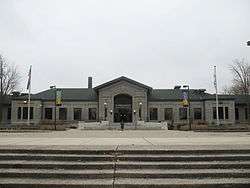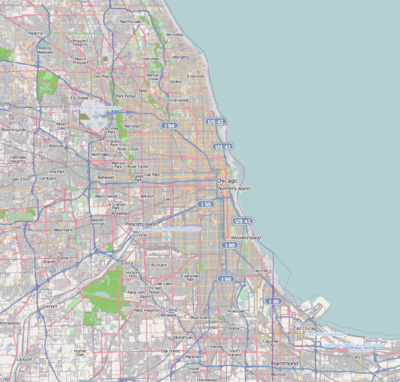DuSable Museum of African American History
 | |
 Location within the Chicago metropolitan area. | |
| Established |
February 16, 1961 (current location since 1973) |
|---|---|
| Location |
740 East 56th Place Chicago, Illinois 60637 United States |
| Coordinates | 41°47′32″N 87°36′26″W / 41.792111°N 87.607306°W |
| President | Perri L. Irmer |
| Website | www.dusablemuseum.org |
The DuSable Museum of African American History is dedicated to the study and conservation of African American history, culture, and art. It was founded in 1961 by Dr. Margaret Taylor-Burroughs, her husband Charles Burroughs, Gerard Lew, Eugene Feldman, and others. Dr. Taylor-Burroughs and other founders established the museum to celebrate black culture, then overlooked by most museums and academic establishments. It is located at 740 E. 56th Place at the corner of Cottage Grove Avenue on the South Side of Chicago in Washington Park. The museum is in an affiliation with the Smithsonian Institution.
History
Founding
The DuSable Museum was originally chartered on February 16, 1961.[1] Its origins as the Ebony Museum of Negro History and Art began following the work of Margaret and Charles Burroughs to correct the perceived omission of black history and culture in the education establishment.[2][3] The museum was originally located on the ground floor of the Burroughs' home at 3806 S. Michigan Avenue.[2][4][5] In 1968, the museum was renamed for Jean Baptiste Point du Sable, a Haitian fur trader and the first non-Native-American permanent settler in Chicago.[6][7] During the 1960s, the museum and the South Side Community Art Center, which was located across the street, founded in 1941 by Taylor-Burroughs and dedicated by Eleanor Roosevelt,[8] formed an African American cultural corridor.[6] This original museum site had previously been a social club [9] and boarding house for African American railroad workers and is now listed as a Chicago Landmark and on the National Register of Historic Places.[6][10]
The DuSable Museum quickly filled a void caused by limited cultural resources then available to African Americans in Chicago. It became an educational resource for African American history and culture and a focal point in Chicago for black social activism. The museum has hosted political fundraisers, community festivals, and various events serving the black community. The museum's model has been emulated in numerous other cities around the country, including Boston, Los Angeles, and Philadelphia.[6]
Expansion
In 1973, the Chicago Park District donated the usage of a park administration building in Washington Park as the site for the museum.[3][4] The current location once served as a lockup facility for the Chicago Police Department.[4] In 1993, the museum expanded with the addition of a new wing named in honor of the late Mayor Harold Washington,[3] the first African-American mayor of Chicago.[11] In 2004, the original building became a contributing building to the Washington Park United States Registered Historic District which is a National Register of Historic Places listing.[12][13]
The DuSable Museum is the oldest and before the founding of the National Museum of African American History and Culture in the 21st century, the largest caretaker of African American culture in the United States. Over its long history, it has expanded as necessary to reflect the increased interest in black culture.[14] This willingness to adapt has allowed it to survive while other museums faltered due to a weakening economy and decreased public support.[15] The museum was the eighth one located on Park District land.[3] Although it focuses on exhibiting African American culture, it is one of several Chicago museums that celebrates Chicago's ethnic and cultural heritage.[16]
Antoinette Wright, director of the DuSable Museum, has said that African American art has grown out of a need for the culture to preserve its history orally and in art due to historical obstacles to other forms of documentation. She also believes that the museum serves as a motivational tool for members of a culture that has experienced extensive negativity.[17] In the 1980s, African American museums such as the DuSable endured the controversy of whether negative aspects of the cultural history should be memorialized.[18] In the 1990s, the African American genre of museum began to flourish despite financial difficulties.[17] In 2016, the museum formed an affiliation with the Smithsonian Institution.[19]
Collection
The new wing contains a permanent exhibit on Washington with memorabilia, personal effects and surveys highlights of his political career.[4] The museum also serves as the city's primary memorial to du Sable.[3] Highlights of its collection include the desk of activist Ida B. Wells and the violin of poet Paul Laurence Dunbar.[20]
The museum has a collection of 13,000 artifacts, books, photographs, art objects, and memorabilia.[4] The DuSable collection has come largely from private gifts. It has United States slavery-era relics, nineteenth- and twentieth-century artifacts, and archival materials, including the diaries of sea explorer Captain Harry Dean. The DuSable collection includes works from scholar W. E. B. Du Bois, sociologist St. Clair Drake, and poet Langston Hughes. The African American art collection contains selections from the South Side Community Art Center students Charles White, Archibald Motley, Jr., Gus Nall, Charles Sebree, and Marion Perkins, as well as numerous New Deal Works Progress Administration period and 1960s Black Arts Movement works. The museum also owns prints and drawings by Henry O. Tanner, Richmond Barthé, and Romare Bearden, and has an extensive collection of books and records pertaining to African and African American history and culture.[6][21]
Facilities
The original north entrance contains the main lobby of the museum and features the Thomas Miller mosaics, which honor the institution's founders. The building was designed c.1915 by D.H. Burnham and Company to serve as the South Park Administration Building in Washington Park on the city's south side.[3] The new wing is 25,000 square feet (2,300 m2). The museum has a 466-seat auditorium, which is part of the new wing, that hosts community-related events, such as a jazz and blues music series, poetry readings, film screenings, and other cultural events. The museum also has a gift shop and a research library.[4] As of 2001, the museum operated with a US$2.7 million budget, compared to a $55.7M budget for the United States Holocaust Memorial Museum.[17] The museum's funding is partially dependent upon a Chicago Park District tax levy.[6]
After the 1993 expansion of the new wing, the museum contained 50,000 square feet (4,600 m2) of exhibition space. The $4 million expansion was funded by a $2 million matching funds grant from city and state officials.[1]
See also
- Barzillai Lew Lew Family
- List of museums focused on African Americans
- List of museums and cultural institutions in Chicago
References
- 1 2 "Tanqueray salutes the DuSable Museum - DuSable Museum of African-American History, Chicago, Illinois". Ebony. Johnson Publishing Company. February 1993. Retrieved 2009-01-13.
- 1 2 "Margaret Burroughs Biography". The HistoryMakers. 2000-06-12. Retrieved 2008-04-15.
- 1 2 3 4 5 6 "About DuSable Museum". DuSable Museum of African American History. Retrieved 2008-04-15.
- 1 2 3 4 5 6 "Chicago Attractions: DuSable Museum of African-American History". The New York Times. The New York Times Company. Retrieved 2009-01-04.
- ↑ "DuSable Museum of African-American History". Chicago Tribune. Retrieved 2009-01-04.
- 1 2 3 4 5 6 Dickerson, Amina J. (2005). "DuSable Museum". Encyclopedia of Chicago. Chicago History Museum. Retrieved 2008-04-15.
- ↑ Wade, Betsy (1991-07-14). "Practical Traveler; Tracing the Trail Of Black History". The New York Times. The New York Times Company. Retrieved 2009-01-27.
- ↑ "South Side Community Art Center". Encyclopedia of Chicago. Chicago History Museum. 2005. Retrieved 2009-01-04.
- ↑ City of Chicago | Landmarks web - Landmark Details - Griffiths-Burroughs House
- ↑ National Register of Historic Places-Griffiths, John W., Mansion
- ↑ Johnson, Dirk (1987-11-26). "Chicago's Mayor Washington Dies After a Heart Attack in His Office". The New York Times. The New York Times Company. Archived from the original on February 15, 2009. Retrieved 2009-01-27.
- ↑ Bachrach, Julia Sniderman (2004-07-02). "National Register of Historic Places Registration Form: Washington Park" (PDF). United States Department of the Interior/National Park Service. Retrieved 2009-04-01.
- ↑ "Illinois - Cook County - Historic Districts". National Register of Historic Places. Retrieved 2009-04-01.
- ↑ Rotenberk, Lori (1992-02-04). "DuSable Museum to get new look". Chicago Sun-Times. Sun-Times Media Group. Retrieved 2009-01-27.
- ↑ Jackson, Cheryl V. (2005-02-01). "DuSable plans expansion as others falter". Chicago Sun-Times. Sun-Times Media Group. Retrieved 2009-01-27.
- ↑ Schmidt, William E. (1990-11-04). "What's Doing In; Chicago". The New York Times. The New York Times Company. Retrieved 2009-01-04.
- 1 2 3 Kinzer, Stephen (2001-02-22). "Arts in America; A Struggle to Be Seen". The New York Times. The New York Times Company. Retrieved 2009-01-04.
- ↑ Williams, Lena (1988-12-08). "Black Memorabilia: The Pride and the Pain". The New York Times. The New York Times Company. Retrieved 2009-01-04.
- ↑ Associated Press (March 25, 2016). "DuSable Museum named as Smithsonian Institution affiliate". Crain's Chicago Business. Retrieved 27 March 2016.
- ↑ Wade, Betsy (1991-07-14). "Practical Traveler; Tracing the Trail Of Black History". The New York Times. The New York Times Company. Retrieved 2009-01-04.
- ↑ "Lincoln Speaks to Freedmen on the Steps of the Capital at Richmond". CivilWarinArt.org. Retrieved 2016-04-15.
External links
| Wikimedia Commons has media related to DuSable Museum of African American History. |
- Official website
- DuSable Museum of African American History on Google Cultural Institute
- Johnson, Steve (17 Sep 2014). "DuSable Museum of African American History: Filling your mind, not your day". Chicago Tribune. Retrieved 18 Sep 2014.